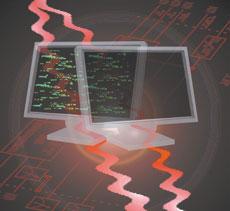Computer thinks when it’s asleep

Courtesy of Onur Hosten
Mar 8, 2006
Last updated on May 12, 2016 at 01:46 a.m.
A computer that can get an answer from an algorithm even when its program is not running – the idea appears mind-boggling, but a University physics team has experimental proof that a quantum-based computer can do just that.
Paul Kwiat, a Bardeen professor of physics, and Onur Hosten, graduate student, fell into the national spotlight after publishing results of experimentation with a simplified version of a quantum computer. Funded by the Disruptive Technologies Office and the National Science Foundation, Kwiat and Hosten fused quantum physics with computing.
“Not much work has been done with combining quantum computing with other kinds of quantum trickery,” said Kwiat, who is helping to pioneer the relatively young field.
Kwiat and Hosten’s studies centered on quantum mechanics, which deal with understanding events at the atomic level. Theory states that it is impossible to gain complete knowledge about any subatomic particle, and its location and other traits exist only as probabilities. This field is full of surprises, one of which is counterfactual computing. Counterfactual computing can be defined as something that runs counter to anything ever experienced.
Get The Daily Illini in your inbox!
Kwiat found that the public is fascinated by the idea of getting something to work that isn’t actually running.
“This particular result has drawn much attention from ‘blog’ sites,” Kwiat said.
Kwiat and Hosten used the quantum mechanics principle of superposition as the basis for their experiment. Superposition says that particles such as photons can be in a range of different states at once at the atomic and subatomic level.
Hosten and Kwiat applied this same physical law to allow the computer to run and not run at the same time. This is what lies at the heart of their experiment.
“(We) put the computer in a superposition of ‘running’ and ‘not running’ and combined the two histories and sometimes got an answer even though it was later determined that the algorithm hadn’t run,” Hosten said.
This answer required a complex set-up of mirrors, lasers, and lenses coupled with the law of superposition. The interaction of the photon in both its conditions with the mirrors, lasers and lenses allowed an answer to be inferred even when it is not running.
Kwiat stressed that the quantum computer used was very simplistic and it will be many years before a practical quantum computer will emerge.
If a quantum computer materializes in the distant future, code breaking could be revolutionized. Kwiat stressed, however, that their recent experiment has more direct relevance in reducing run-time errors in quantum algorithms.
Further information regarding Kwiat and Hosten’s findings and the intricacies of that process were published in the journal Nature on Feb. 23.





